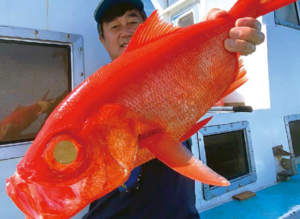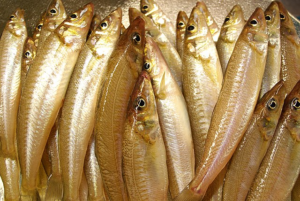Sabiki in Japan
Sabiki is a well known word, standing for one type of boat fishing rig, globally.
It has a kind of down shot style, with multiple branched hook leaders attached on the main line. Often there are 6 to 8 pieces of hooks attached, and each hook has additional materials on its shank. With these materials, the hook imitates the baits, often small shrimps, to lure target fish. Sometimes, people use chumming with this rig to attract more fish.
Probably if I dare pick up the difference between its usage in Japan and in other parts of the world, Japanese anglers use sabiki rig to catch their ultimate target fish in most cases, while in other countries it is, commonly, used to catch the bait fish to be used for larger target fish.
In this article, I would like to introduce the typical Japanese sabiki fishing, in the first part. Secondly, the types of sabiki hook materials will be shown. And then show you the origin and the history of this unique rig.
Sabiki fishing in Japan
Since it is one of the easiest ways to catch fish, sabiki is one of the recommended fishing styles to experience fishing for the first time, from piers.

In this beginner friendly sabiki style, we use chumming of Ami-ebi (small shrimp, Acetes, or Pacific krill, Euphausia pacifica, or small krill, note; in this article the term of Ami-ebi is include all these species). And the rig has a small feeder basket or small net to hold this chum. Hooks are imitating these chumming shrimps, in size and color.

People are placing their rigs into the water, and give a lift and fall to release these basketed chum. As fish are attracted by that and coming closer, fish mistakenly eat the hooks, amid their party in the cloud of chum.
The main fish species with this style are; Jack mackerels (Trachrus japonicus), Chub markerel (Scomber japonicus), Sardines (Sardinops melanostictus), Japanese anchovy (Engraulis japonicus), and so on. The targeted size is up to 15 cm, for any species. As all of them are moving in schools, once you see them and can keep them near you while chumming, it is easy to catch a lot.
There is also sabiki fishing without chumming. This is not the majority since the result of this style hugely depends on the condition, or how schools of fish are moving. But there are certain types of sabiki rig, which is purposed for this style.
In boat fishing, it is more often that this sabiki without chumming is used. As anglers search deeper with the rig from the boat, fish are less cautious and easy to attack the sabiki hooks without chumming. In this case, these sabiki targets to catch bait fish.
Another, rather new, type of sabiki is Jigging sabiki. Instead of the sinker at the end of the rig, it takes the metal jig.

You use the rig just the way you are fishing with a jig. The additional hooks (sabiki part) with these flashy materials work as visual attractants. Since it can go with jigs, its target fish includes more predatory fish, such as Sea Bass (Lateolabrax japonics), Japanese amberjack (Seriola quinqueradiata), Bastard halibut (Paralichthys olivaceus), Flathead (Platycephalus), as well as larger size Jack makerel and Chub makerel. The rig has thicker lines and larger hooks, naturally.
The types of sabiki hooks in Japan
If you categorize the types of sabiki hooks (types of elaboration attached on hooks,) these are as below.
Fish skin
Dried skin of leather fish, mackerel. These are natural and historically proven.

Feather or threads
Thin and shiny tinsel and colored synthetic fabrics. These are useful to make the total length longer or larger.

Rubber or nylon
Soft latex, soft lure material, small stripe of nylon. These are easy to adjust shape and color to imitate something.


Other materials
Beads (colored, sometimes night glow material)
The use of fish skin is proven by Japanese fishermans. But it's not clear how the fish skin works. It may be to imitate small fish or to make natural reflections of sunlight. After this dried skin gets wet, it becomes softer or more transparent to imitate small fish or whitish Ami-ebi. It has been one of the most used ways historically, and you can say it is a well proven way.
Softer materials such as features or threads allows the part to move naturally with the movement of water. The thin and long part of shrimps or end tip of small fish’s fins moves with the water. As some of you may know, this long ribbon shaped part of lure (the thread attached on Tai rubber, long straight soft lure or pin-tailed type worm) is effective in some situations.
Rubber or nylon materials can be in various colors. With these, you can make the sabiki hooks just like the chumming shrimps.
Origin of sabiki
As is often the case for other rigs, this sabiki rig was not invented by someone, but made by convergence of various factors.
These factors are;
- Boat fishing rig for Jack makerel
- Japanese traditional lures
- Increased usage of Ami-ebi
- Selling of first mass production sabiki for beginners
- Expansion of piers around big cities
The first factor is intuitively easy to imagine. The more hooks you have in one line, the more likely to get multiple fish. It was introduced in a book about history of fishing tackle, published in 1912 (日本水産補採史). The rig shown in the book has 8 hooks. And it explains that those hooks had sometimes with the additional threads on its neck.

Along the course, there were some Japanese lures invented, for different uses. As one of my previous articles about Tai rubber explained (link to the article) there were Japanese traditional lures for target fish such as bonito or amberjack. The materials of these lures are bird feathers and fish skins.


And these two met at some point to make the rigs similar to the one presently seen.
By the time of the early Showa era, there were such rigs recorded in a book, as image below.

For sabiki to be popular, three matters following affected a lot, additionally.
The use of Ami-ebi, the debut of the first beginner friendly sabiki rig and the expansion of piers.
Presently, the most popular chum in sabiki is Ami-ebi, while materials for chum, in Japan, are ground fish meat (often used for boat fishing), paste bait (the mixture of rice bran powder and ground silkworm pupa etc. for rocky coast or Iso fishing), Krill (boat and Iso fishing), Ami-ebi, live freshwater shrimp, and dead fish (Pacific sand lance, Ammodytes personatus, etc.)

For the ease of handling, Ami-ebi is the most popular choice in sabiki now. But it was not so much until the 1970’s. Until then, the total amount of caught Ami-ebi was not large enough to bring the price accessible for anglers. They were not economical to be used as chumming, in the way we use them currently. There were people who used them, but they must have used it in small amounts. Around the 1970’s, the volume of landed Ami-ebi was increased, because commercial fishermans started to use efficient ways to catch them (using larger boats or effective nets.)

And it made the price of Ami-ebi lower. It made this more accessible for anglers to use it as chumming. Once anglers started to use larger volumes, they found that it worked very well to gather fish nearby.
This timing of Ami-ebi increase met the maturation of the Japanese economy. As the economy of Japan grew, or matured, people had more time and money for leisure activities. Then, fishing was one of the popular leisure activities, and it is said that the pier was crammed by people.

This increase was also supported by the start sales of new rigs. The easy to use sabiki rig package went into the fishing shops in 1974.

This rig had a well made hook design, with the thin colored latex. The color and shape was just the same as Ami-ebi. It made a big hit in the market, and helped the expansion of sabiki’s popularity.
Additionally, it is at this time that Japan had built many piers around big cities. One of the significant events relating to it was that Tokyo port had received the very first full sized container ship, in 1967. Government statistics tells us that the amount of import using seaports increased by 5.3 times more in 10 years, from 1960 to 1970 (changed from 92,210 to 493,000 k Tons, link to the report.)

In most of these new ports, people could go fishing relatively freely. They served very good opportunities for people to enjoy fishing, in safe and easy places on piers. They were nice to bring children and sabiki served a very important role in bringing back many fish back home. (Note: Unfortunately, currently, the situation has changed and controls of these piers are stricter for security reasons and facilities are getting older. And we have less and less piers to enjoy fishing.)
When you start boat fishing anywhere in the world, sabiki is probably the best way. It is a simple style but there are many decisions you have to make, such as selection of hooks with elaboration etc. You can ask your captain what the best one is. When you think about it, please remember you have many types of skins or rubbers on the hooks, in Japan.
Additional reference…
Here are pictures of the latest, cutting edge sabiki hooks. All are from Hayabusa. (Link)
These details are showing real Japanese fishing tackle!








2 thoughts on “Sabiki in Japan”